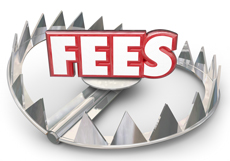Saving enough money for retirement can be a tricky proposition even under the best circumstances.
But when some of those dollars are being siphoned away by hidden — and perhaps unnecessary — fees, then the path to a secure retirement becomes even more difficult to navigate.
Even small fees can have a major impact over time, which is why people need to be aware of what they are being charged, and whether other options exist that make for a better and smarter investment
Probably 99 percent of people have no clue what they are really paying in fees and expenses. They are bleeding out their life savings. Those hidden fees, which are abundant in the financial industry, are my number-one frustration with the profession.
There are a couple of products that consistently illustrate the problem with hidden fees — mutual funds and variable annuities. Many people believe their retirement advisor only makes money when something is bought or sold. But that’s not always the case.
With mutual funds, for example, some fees are disclosed in the prospectus for the funds, but often there are additional ongoing fees that are not consistently or adequately disclosed.
Some of those mutual fund fees and costs include:
Stated Expenses
- Loads. Different classes of mutual funds have different types of loads or charges that are similar to commissions in that they compensate the financial professional for selling the fund to you. Some are front-end and you are charged at the time you make your initial investment. That charge usually is about five percent. Others are back-end, meaning you are assessed the charge if you sell the mutual fund, usually within a specified time frame.
- Expense ratios. Other than loads, this is the only cost many retirees and pre-retirees are aware of. The expense ratio is used to pay distribution costs, administration fees, management fees and marketing costs. The expense ratio can be one percent or more, depending on the mutual fund. According to the Investment Company Institute, the average expense ratio in an equity mutual fund is 1.4 percent per year.
- Advisory fees. In addition to the internal costs of owning a mutual fund, you may be paying a management fee to your advisor. This fee can range anywhere from 0.25 percent up to 2.5 percent. Even if you aren’t aware of it, you should be able to determine how much this one is costing you because it is required to be disclosed on investor documents.
Unstated Expenses
- Soft dollar costs. One of the most difficult mutual fund expenses to uncover is soft dollar costs. Often, mutual fund managers are provided software, education, research or other services by brokerage firms. In exchange for these benefits, the brokerage house gets the brokerage business and may charge a higher commission for the trading of stocks within the fund. That commission is paid by the investor.
- Tax Impact. Mutual funds are pass-through entities, meaning you pay tax on every transaction inside the mutual fund whether you benefited or not. The average tax cost ratio for stock mutual funds is one percent to 1.2 percent annually, according to a Forbes magazine article.
- Trading Commissions. Potentially one of the largest undisclosed expenses inside a mutual fund is trading commissions. Every time something is bought or sold within a mutual fund there is a commission charged and, believe it or not, these costs legally do not need to be disclosed. A Wall Street Journal article noted that a 2009 study of thousands of U.S. equity mutual funds showed that the trading costs investors, on average, 1.44 percent.
Once you know about the fees and charges attached to mutual funds, you may be able to negotiate to lower some of them. I regularly audit investors’ portfolios and find expenses in excess of three percent annually.
I also often recommend “separately managed accounts” as an alternative to mutual funds because there are no loads and there is more transparency. Separately managed accounts are somewhat similar to mutual funds, but can be tailored specifically to the individual needs of the investor.
Regardless of the investment, it is vitally important to understand how valuable it is to avoid hidden fees and charges that can add up and prove costly, especially over decades. You want to keep as many of your hard-earned dollars in your account and working for you as possible.



